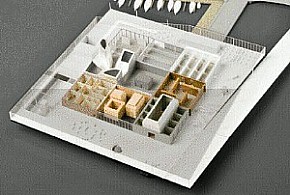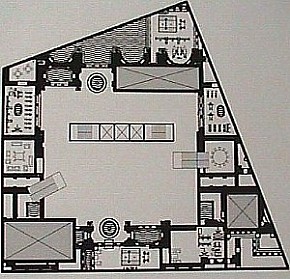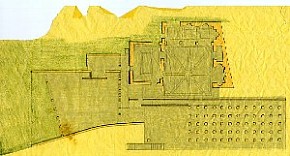2009.09.27 14:38
Who are the URMs in architecture grad school?
So, maybe, if architecture school wasn't such a pretend thing, the minority would excell and the majority would fail?
2009.10.04 11:55
Examples of modern exterior with traditional interior
I was wondering if anyone can point me to some specific examples of built works that have a modern exterior or shell with a traditional/historic interior design. Is there anything out there like Villa Savoye on the outside with like Rococo salons and/or Gothic kitchens and/or Turkish baths on the inside? Maybe Barcelona Pavilion on the outside with Greek temple interior? No hurry. Was just suddenly inspired to ask.
2009.10.06 15:59
Examples of modern exterior with traditional interior
somewhat akin to the Getty...
 
REX, Munch Museum, 2009
The compartmentalized approach leads to any number of mix-up possibilities.
otherwise...

Level 1: lobby, bar. restaurant, spa, fitness, banquet rooms.
OMA and Herzog & de Meuron, Hotel Astor Place, 1999.

SL, Mayor's House, 1990.
| |
2009.11.16 09:55
The current state of Architecture Theory
"The ability of the computer to locate every point on a carved surface does away with the need for rational comprehension on the part of the designer in conceiving, or the observer in perceiving, a building. Thanks to the computer, pure empiricism has no longer any practical need for the mediating grasp of the intellect. The maximum of an empirical nominalism coexists with the maximum of abstraction. The space between nominalism and abstraction is left void. The mind no longer needs to understand itself. After a long evolutionary detour, human thought returns to its primitive instinctual roots."
Colquhoun (2005)
"...I was entranced by the work of James Gamble Rogers, the architect who designed most of Yale's Gothic and Georgian architecture in the 1920s and 1930s. Roger's determinedly nonideological stance, his avoidance of theory in favor of what can only be called intuitive design, was liberating. It was alright for architecture to be about feeling good, I suddenly realized; stage sets were not immoral. It was the perfect epiphany for a twenty-year-old who was just beginning to learn about empirical experience and only starting to trust his eye."
Goldberger (2009)
2009.11.16 15:25
The current state of Architecture Theory
Jargon aside, it is now progressively easier for intuitive design intentions to become reality.
2009.11.17 11:42
The current state of Architecture Theory
Alan Colquhoun, Collected Essays in Architectural Criticism (2009), p. 342. Within the lecture "Changing Museum" (2005).
The passage relates specifically to Gehry's Guggenheim Bilbao, and was included here because it somewhat relates to my 'opinion' 2008.08.22 22:05.
2009.11.17 16:17
The current state of Architecture Theory
I like my raspberry bushes because they bear fruit twice a year, mid-spring and mid-autumn (like right now). And although still seasonal in their development, there's also this kind of double-helix thing about it.
Architecture theory structured as DNA?
Colquhoun's passage isn't really about how modeling systems work, rather how digital (modeling) data can be manufactured. It's about the voiding of the mediating grasp within the design/execution process. (Not too dissmilar from the voiding of the mediating grasp within the design/execution of self-publising, eg, blogging.
2009.11.17 16:48
The current state of Architecture Theory
That's closer to what Goldberger said. It looks like you're interpolating from both quotations, which, for the most part, is fine, because there is, as you just unwittingly demonstrated, something about the the two quotations intertwined that could well be the germinating point of a[n architectural] value system.
| |
2009.11.17 17:42
The current state of Architecture Theory
Perhaps the struggle today is more with the dual reality of "anything goes" and "whatever works".
2009.11.18 11:31
The current state of Architecture Theory
It's not that "there really isnt meant to be any real thought there" but that "intellectual rigor" really isn't necessary to design architecture. In fact, it could well be asked: Does it really behoove us to mask our lack of depth and our inability to achieve real, effective, incisive strength in our work with intellectual nonsense? A lack of depth and an inability to achieve real, effective, incisive strength are not fixed with intellectual rigor, rather they are fixed via design rigor. The architectures of Zumthor, Predock and Chipperfield (for example) do not stand out because of their intellectual rigor, but because of their design rigor.
Yet design rigor isn't always necessary to create architecture either. Gehry's architecture exhibits a very high-grade design facileness, and maybe that is indeed something rare.
As for the "computer people", the various/sometimes architectures of Hadid and UnStudio (again for example) well demonstrate being beyond "figuring it out", and they're even doing it rigorously.
I'm not here trying to express my opinion, as much as I'm experimenting with establishing some kind of baseline for architectural theory to build upon. I am of the opinion, however, that honesty, or at least objective observations and assessments of present conditions, is a fair place to start.
2009.11.18 13:40
The current state of Architecture Theory
Is it Eisenman's words, or Eisenman's designs that might of made the likes of UNStudio, FOA and Lynn possible?
2009.11.19 17:32
The current state of Architecture Theory
Computers are not competing with thinking.
For the sake of the argument here, computers greatly augment/assist instinctive/intuitive design thinking. Designing instinctually/intuitively (for example, Savoye derivatives) doesn't mean you're designing without thinking.
2009.11.25 11:29
I propose a ban
Render the proposed building with lots of people.
Photograph the executed building with no one present.
Funny that.
2009.11.27 12:10
The current state of Architecture Theory
an (experimental inclined toward intuitive) architectural theory:
architectural design falls into three types:
intuitive architectural design
theoretical architectural design
experimental architectural design
with the three types forming a triade, thus each type can incline towards one or the other.
e.g.
the architecture of Frank Gehry -- intuitive architectural design inclined toward experimental architectural design
the architecture of Peter Eisenman -- experimental architectural design oscillating between theoretical and intuitive architectural design
the architecture of Le Corbusier -- theoretical architectural design oscillating between experimental and intuitive architectural design
Gothic architecture -- experimental architectural design inclined toward intuitive architectural design
Beaux Arts architecture -- theoretical architectural design oscillating slightly between experimental and intuitive architectural design
the architecture of Louis I. Kahn -- started as theoretical architectural design and ended as experimental architectural design inclined toward intuitive architectural design
the architecture of H&dM -- experimental architectural design inclined toward intuitive architectural design
the architecture of UNStudio -- theoretical architectural design inclined toward experimental architectural design
[to be continued]
| |
2009.12.05 12:42
where's the avant garde?
Get a notion or idea
that most will resist,
and chances are
that it's avant garde.
2010.10.15 15:39
Can Someone Explain the Meaning of Projective Practice?
"To understand what exactly is meant by these terms hermeneutic and material practice it is perhaps more interesting if we compare them with a third term 'projective practice' which aims at a very similar redefinition of practice and places these 'redefinitions' in the context of the current debate described earlier. The term 'projective' is put forward in the article 'Notes around the Doppler Effect and other Moods of Modernism' by Robert Somol and Sarah Whiting. When Somol & Whiting introduce the term 'projective'. They also address the problem of the theory-practice distinction but in a far more indirect way, in their argument these are still very much intertwined. The article starts off with the heading "from critical to projective". This needs some further explanation. . ."
Edwin Gardner, 2010.10.12
Lots of similar articles all over the web.
I remember enjoying Aureli and Orazi's "The Solitude of the Project" and maybe this time I'll again finish Tafuri's "The Historical 'Project'".
As to definitions, this is my favorite:
projective 1 b : not metrical : not involving size and measurment but only relative position, incidences, and coincidences
especially the coincidences.
Like I've already said, all the world's a next stage.
2010.10.27
does abstruse architecture theory work like this?
from Nicholas Carr, The Shallows: What the Internet is Doing to Our Brains, p. 204:
"In commenting on his creation, which he acknowledged to be a modest and slightly silly contribution to the fledging field of natural-language processing, Weizenbaum observed how easy it is for computer programmers to make machines "behave in wondrous way, often sufficient to dazzle even the most experienced observer." But as soon as a program's "inner workings are explained in language sufficiently plain to induce understanding," he continued, "its magic crumbles away; it stands revealed as a mere collection of procedures, each quite comprehensible. The observer says to himself 'I could have written that.'" The program goes "from the shelf marked "intelligent" to that reserved for curios."*
*Weizenbaum, "ELIZA."
With regard to "I could write (do) that," is this what happens when architecture theory is written in plain language? And, conversely, is some architecture theory abstruse so others think (implicitly) "I couldn't do that"?
2010.11.13 11:41
I'm apologizing in advance.
Perhaps the days of worthwhile-content-given-freely is steadily on the downswing (perhaps especially when given freely to an otherwise profitting site).
If worthwhile content received remuneration, there'd be lots of discourse.
| |
2010.11.14 18:00
Verisimilitude
All architecture is artificial, even to the point where you can say that architecture is the most artificial thing on this planet. And if architecture is to be truthful, it can really only be truthful to its artificiality. Moreover, it is that architecture that most pushes its artificiality to the extreme/edge that becomes the best architecture.
I'm speaking here mostly of real architecture, designs that are built. Virtual architecture (designs that could be built but aren't) and post-real virtual architecture (architecture that was built but no longer exists) express their truthfulness in other ways.
2010.11.15 10:12
Verisimilitude
Technological consumption is a crafted reality.
2010.11.15 12:26
Verisimilitude
Some of Piranesi's virtuality becoming real. (It seems this has been discussed somewhere here before.)
Here the newly real is not only extremely truthful to its artificiality, but extremely truthful to its over 200 year old virtual precedent as well.
2010.12.07 16:06
"On Criticism" an aggregate thread
For me, criticism has always been an un-strictly-written phenomenon. The intended results come much quicker that way.
2010.12.08 11:07
"On Criticism" an aggregate thread
Exactly five years ago today I successfully suggested what Koolhaas's 2006 Serpentine Pavilion would look like. Did Rem even know [what it would look like] at the time?
2010.12.22 17:14
Predict the new "-ism" for 2011.
Esqueism
as in ism is out and esque is in
Romanesqueesque
Industrialesque
Modernesque
Post-Modernesque
Deconstructionistesque
Boxesque
Blobesque
Furnessesque
LouisIKahnesque
Stirlingesque
Hejdukesque
ScottBrownesque
Eisenmanesque
OMAesque
HdMesque
MVRDVesque
Zahaesque
Whiteesque
Grayesque
Greenesque
|